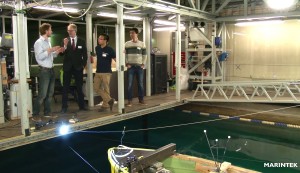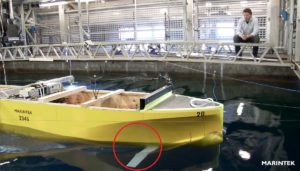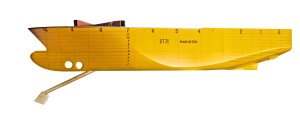Whale tails can make for efficient seafaring
If testing goes well, an invention that helps save fuel in ships may soon be in production, with the support of the British industry.
WAVE FOIL: Researchers from the Norwegian University of Science and Technology (NTNU) are testing a model “whale tail” that can be attached to ships. NTNU is conducting these tests in the Marintek Towing Tank in cooperation with Rolls-Royce and the British companies Seaspeed and MOST.

Eirik Bøckmann, Stephen Phillips, Alastair Sim and Ie-Bum Shin discuss their work in the Towing Tank. Photo: Ingvil Snøfugl, Siw Hermanstad, Marinek/SINTEF
A 1:16.57 scale model ship is attached to the back of the platform that sails the man-made waves of the ship model tank. It only takes a few seconds to cross the 200-metre-long tank, but valuable information is still being collected. Cameras and advanced measuring equipment show how the model moves, the resistance against it, and how changes affect it.
The person responsible for testing this invention is Eirik Bøckmann, a postdoctoral fellow at the Department of Marine Technology at NTNU. He has been working on this idea for several years.
Using wave energy
The main goal of the whale tail is to help reduce fuel use by using wave energy to help the ship move forward.
A whale tail may not be the first thing that you think of when you see this invention— it looks like two wings, or fins that are attached to the front of the ship. But the principle behind the energy saving is about the same as in a whale tail.
The waves that hit the ship model cause it to move, which in turn causes the fins to move up and down just like a whale tail would. The shape of these fins allows energy from the waves to help the ship move forward.
Reduces resistance and pitching
The preliminary results are very promising.
“The foils reduced resistance on the ship by between 9 and 17 per cent at wave heights of under three metres,under the conditions that we’ve tested,” says Bøckmann. This is a fairly normal wave height in the North Sea and the Norwegian Sea.

Eirik Bøckmann tests an artificial whale tail in the Towing Tank at Tyholt. Photo: Ingvil Snøfugl, Siw Hermanstad, Marintek/SINTEF
“The resistance can probably be further reduced by optimizing the ship’s hull for the wave foils. The foils also reduced the ship’s heaving and pitching by about the same amount as for resistance,” he continues. Results are promising, but they are still in early stages of testing.
“We need to see how things work, and then choose the best way forward based on that,” says Alastair Sim, a technologist at the Rolls-Royce Strategic Research Centre.
Sim says that he sees a lot of potential for this invention if it works the way it is intended. Sim is responsible for evaluating new marine technologies and helping to decide what Rolls-Royce should fund.
It isn’t enough for the wings to just work. Other factors also play a role. For example, the wings also need to be able to take a beating and not destabilize the ship.
The shape and angle of Bøckmann’s fins are unique, but similar inventions have been tested and used previously.
More fins
Three thousand ship models and 1250 propellers have been test in the Towing Tank at Tyholt in Trondheim since it opened in 1939. That means the centre has no shortage of experience working with new technologies, and is one of the world leaders in its field.
“British authorities wanted to include us in this project,” says managing director of Seaspeed, Stephen Phillips.
Phillips started Seaspeed in 1990, and has a few decades of experience working with and improving high speed ships. Seaspeed has experimented with fins, or what are also called “wave foils” for several years.
Seaspeed works together with Rolls-Royce Marine to help develop fins like this for use in commercial marine transport.
Rolls-Royce Marine has collaborated with researchers at the towing tank for a number of years, but this specific project started in 2013.
Rolls-Royce Marine also recently signed a long-term research and development agreement with NTNU and SINTEF MARINTEK.
The future
So how feasible is it that wave power will be an important part of seafaring in the future?
“There has already been small scale development of boats that use only wave power, and have no motors,” says Ie-Bum Shin, who is a naval architect at Seaspeed. But it will be a long time before this technology can be used in full scale. The current goal is just to cut fuel costs.





